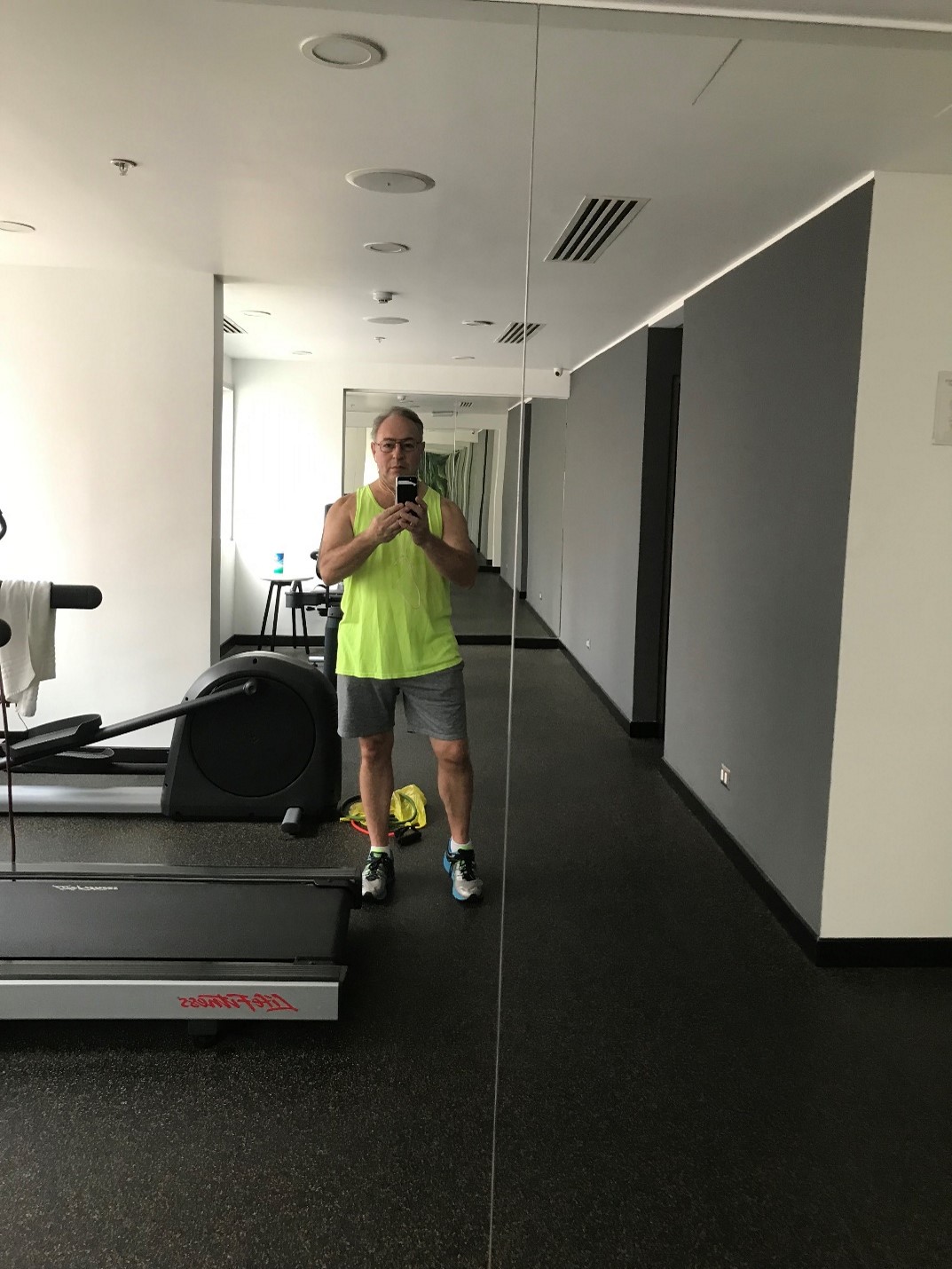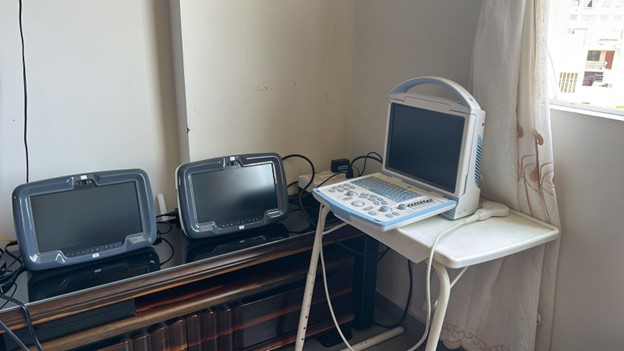Where we last left off, the MIMAs team had arrived in Lima, hoping to enjoy somewhat of a “Consolidation” day, before a next-day, early-morning flight to the city of Iquitos, the capital of the Maynas Province within Peru’s Loreto Region (its northernmost).
 The day started early – 6:00 am. I got up, checked emails and then headed down to the Mercure hotel’s small gym. After sitting on a plane so long yesterday, it felt good to get in a workout. I have included a picture of myself in the gym. Yes – I looked tired. I must admit – I did not enjoy taking the selfie and I believe no others will be forthcoming.
The day started early – 6:00 am. I got up, checked emails and then headed down to the Mercure hotel’s small gym. After sitting on a plane so long yesterday, it felt good to get in a workout. I have included a picture of myself in the gym. Yes – I looked tired. I must admit – I did not enjoy taking the selfie and I believe no others will be forthcoming.
Once finished at the gym, I headed down to breakfast to meet my fellow travelers Brian (MIMAs founder, Dr. Garra), Ben (Benjamin Castaneda, PhD), and Leslie Trujillo. Ben is a professor in biomedical engineering at Pontifical Catholic University of Peru (PUCP) and a MIMAs board member. Leslie also works for PUCP in a business role, as well as working as the administrator (and the person who makes everything happen) for MIMAs. I had not seen them, other than by online chats, since just before the pandemic hit three years ago.
 The included hotel breakfast was very good. I had another lesson in humility this morning when the waitress tried to ask me questions which I was incapable of understanding. I don’t know if this was the result of accent, speed, or both – but I simply could not make out what she was saying. She was very patient and very nice, ultimately using the universal language of gesticulating, resulting in a platter of fried eggs and fresh fruit.
The included hotel breakfast was very good. I had another lesson in humility this morning when the waitress tried to ask me questions which I was incapable of understanding. I don’t know if this was the result of accent, speed, or both – but I simply could not make out what she was saying. She was very patient and very nice, ultimately using the universal language of gesticulating, resulting in a platter of fried eggs and fresh fruit.
Ben arrived first, and we picked up right where we had left off years ago in person. Brian arrived shortly after Ben. Although he had landed at 1:00 am and gotten less than four hours sleep, Brian was ready to go. Leslie arrived later, after finishing another meeting covering our future logistics that ran long.
Our “reunion” breakfast was cut short, because the transportation arrived early. We had scheduled a morning meeting with a company with which MIMAs had partnered, Medical Innovation Technologies (MIT).
Now is probably a good time to explain the role of Medical Innovation Technologies in our venture. Dr. Garra’s Volume Scanning Imaging (VSI) protocols were pioneered in 2007. These were tested in rural Vermont, then in the Central-American nation of Belize, and deployed into the field for the first time in Uganda in 2011. I participated in these initial deployments with a group called Imaging the World (ITW).
The methodology involved input of the VSI ultrasound images into a laptop with specialized software to organize and compress the sweeps before transmitting the cases to a PAC system through cellular data uploads. This process required some degree of knowledge from the user to start the laptop, open the program, and assure connection to a cellular network. When the studies did not transmit successfully, the user might have to take additional steps. The process worked, but required more training and added a layer of complication. This is where Medical Innovation Technologies in Peru came in.
As a company, they liked the idea of VSI scanning and saw how this approach could be used to facilitate a wider use of ultrasound scanning throughout the country. They embarked on creating a “medical box” to take over all of the tasks of the laptop and software, including the case export capability. They also added some tutorial functionality onto the platform in addition to developing a cloud service for importing the cases, assigning the reading, creating the interpretation and sending the results back to the clinic. Their system improved much of the reporting that was being done previously on paper, and/or transmitted back to the clinics via SMS texts.
Our meeting at Medical Innovation Technologies went well – and at the conclusion we carried away the two (“medical box”) systems which we would bring to the villages in Peru’s northeastern Amazon. Everything was going on time and as planned, so we headed out to lunch. We shared a few very tasty Peruvian meals and headed back to work. This is when the day went from the expected to the unexpected.
 As we initialized the ultrasound system, an error-warning flashed (in Spanish) that related to the device’s air filtration and cooling. With less than 24 hours before our early-morning flight to Iquitos, there was no time to have repair or maintenance performed on the machine. Our options being limited, yet knowing my engineering background – it was decided that I should attempt to take apart the system and see if the cooling fans were the cause of the error-warning. Once we found tools and got the system apart, on boot up, I noticed that one of the little DC box fans was stuttering. Now began the scavenger hunt. We went to multiple stores and could not find a replacement fan. Spending this unexpected time meant we were now behind schedule on everything else – and we were no closer to having a working system. Keep in mind that this equipment will be used in the Amazon, so having a system with a dead fan is not really a great option.
As we initialized the ultrasound system, an error-warning flashed (in Spanish) that related to the device’s air filtration and cooling. With less than 24 hours before our early-morning flight to Iquitos, there was no time to have repair or maintenance performed on the machine. Our options being limited, yet knowing my engineering background – it was decided that I should attempt to take apart the system and see if the cooling fans were the cause of the error-warning. Once we found tools and got the system apart, on boot up, I noticed that one of the little DC box fans was stuttering. Now began the scavenger hunt. We went to multiple stores and could not find a replacement fan. Spending this unexpected time meant we were now behind schedule on everything else – and we were no closer to having a working system. Keep in mind that this equipment will be used in the Amazon, so having a system with a dead fan is not really a great option.
After many hours, we gathered together images of the part and specs which Leslie sent to her brother who lives closer to the heart of Lima’s downtown – about an hour travel in traffic away, where electronic markets exist. He found a fan that met the specs after a few hours of searching, but its connector was not compatible. This meant that we could have to cut off the connector and solder wires together. So at those same markets he had to purchase a soldering iron and solder – as we, of course, did not bring that with us.
While we waited for the parts to arrive, we determined another suitcase would be needed to fit all the electronics and training materials. Off to the stores with a tape measure, in search of an affordable suitcase, we went. Unfortunately, by this time it was 9:30 pm. After a walking about Miraflores and near John F. Kennedy Park (sometimes referred to as El Parque De Los Gatos – because of the number of cats) we found a suitable suitcase. We could now finally get dinner while waiting for the parts to arrive. The group decided to return to the restaurant where I ate last night and dinner began at 10:30 pm.
There we met up with Lorena, another MIMAs board member who currently works for the United Nations. At least we had some great food as you can see – some closeup pics of the food are included for the epicureans amongst you.
At midnight the fan was installed and worked –a huge relief for Brian and me. We got back to the hotel at 12:30 am, with the plan to be out by 7:30 the next morning (with suitcases packed) ready to head to the airport.
Thank you for sharing this journey with me. Look for my next installment soon. Below are hyperlinks to the prior blogs on Bringing VSI imaging to the Amazon of Peru:
BRINGING VSI IMAGING to the AMAZON of PERU (Intro/Chapter 1)
BRINGING VSI IMAGING to the AMAZON of PERU (Chapter 2)
Frank Miele, MSEE , President of Pegasus Lectures, Inc. Frank graduated cum laude from Dartmouth College with a triple major in physics, mathematics, and engineering. While at Dartmouth, he was a Proctor Scholar and received citations for academic excellence in comparative literature, atomic physics and quantum mechanics, and real analysis. Frank was a research and design engineer and project leader, designing ultrasound equipment and electronics for more than ten years at Hewlett Packard Company. As a designer of ultrasound, he has lectured across the country to sonographers, physicians, engineers and students on myriad topics.





